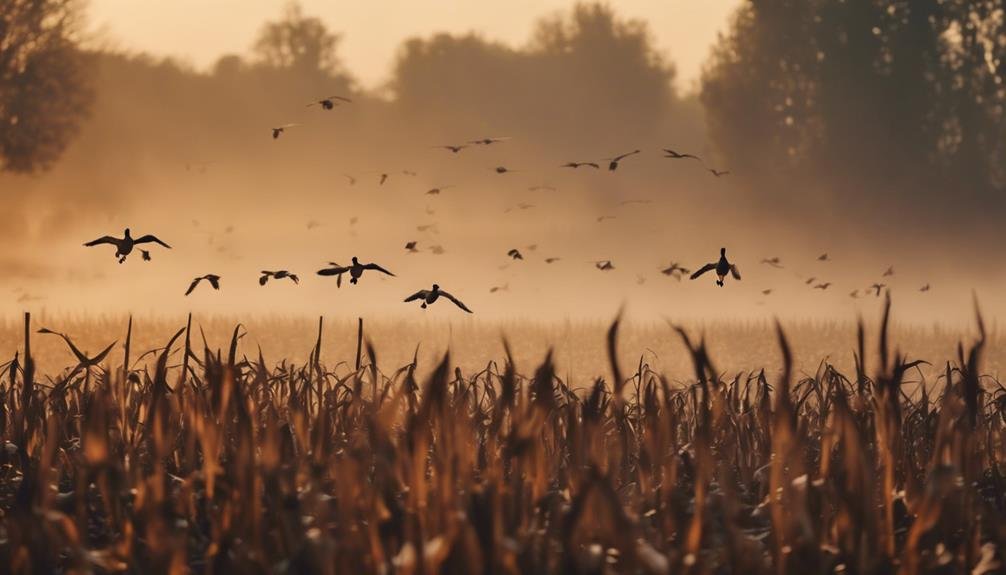As puddle duck hunting season approaches, experienced hunters know that success hinges on staying one step ahead of their elusive quarry. Understanding duck patterns, scouting, and flexibility are crucial in setting up effective decoy spreads. Investing in top-quality gear, mastering decoying and camouflage techniques, and developing a personalized hunting strategy aligned with strengths, weaknesses, and preferences are essential for a successful hunt. With puddle ducks exhibiting distinct patterns and habits, staying adaptable and continuously monitoring changing water conditions is vital. By grasping the intricacies of puddle duck behavior, hunters can refine their approach and unlock the secrets to a bountiful harvest.
Key Takeaways
- Scouting and flexibility are key to success in morning hunts, as puddle ducks can change habits quickly.
- Understanding puddle duck behavior and patterns helps anticipate their movements and habits.
- Setting decoys in areas where ducks have been seen landing in the past few days increases chances of success.
- Adapting to changing water conditions is crucial for staying ahead of puddle ducks and requires adjustments to decoy setup and calling techniques.
- Hunting during early morning hours increases chances of success, as puddle ducks are most active during this time.
Hunting Strategies for Success
To maximize success in puddle duck hunting, it is essential to employ strategic tactics that take into account the behavior and patterns of these birds, as well as adapt to the ever-changing hunting environment. Understanding duck patterns, such as their feeding habits and roosting areas, is vital in setting up effective decoy spreads. Field etiquette also plays a significant role, as respecting other hunters' space and following established protocols can make or break a hunt. By combining knowledge of duck behavior with adaptability and respect for fellow hunters, puddle duck hunters can increase their chances of success. By being mindful of these factors, hunters can develop a strategy that capitalizes on the unique characteristics of puddle ducks, ultimately leading to a more successful and enjoyable hunt.
Essential Gear for Puddle Ducks
When it comes to puddle duck hunting, having the right gear can make all the difference between a successful hunt and a dismal one, which is why First Lite's range of gear, including the Uncompahgre 2.0 Puffy Jacket and Rugged Wool Zip Hoody, is essential for staying warm, dry, and comfortable in the field. These innovative pieces of gear are designed specifically for wetlands exploration, where puddle ducks thrive. With First Lite's gear, hunters can focus on the thrill of the hunt, rather than worrying about the elements. From the Furnace Quarter Zip to the Origin Hoody, each piece is crafted with gear innovation in mind, ensuring that hunters stay protected and focused on the task at hand. By investing in top-quality gear, puddle duck hunters can increase their chances of a successful and enjoyable hunt.
Mastering the Art of Decoying
In puddle duck hunting, decoying is a crucial aspect of the hunt, requiring a deep understanding of duck behavior and a strategic approach to placement, spacing, and presentation. By mimicking the behavior of real ducks, decoys can be incredibly effective in attracting puddle ducks. Decoying mastery involves:
| Decoy Placement | Waterfowl Behavior | Tips |
|---|---|---|
| Edge of the water | Puddle ducks feed in shallow water | Place decoys near shorelines |
| Open water | Puddle ducks congregate in open areas | Spread decoys out, 10 feet apart |
| Narrow channels | Puddle ducks use channels to move | Place decoys facing into the wind |
| Near vegetation | Puddle ducks hide in vegetation | Use decoys with natural camouflage |
| In areas with recent activity | Puddle ducks return to familiar spots | Set up decoys where ducks have been seen |
Effective Hunting Techniques
Effective hunting techniques for puddle ducks involve a combination of stealth, strategy, and adaptability, as these birds can be notoriously wary and require a thoughtful approach to successfully bag them. For morning hunts, scouting and flexibility are key to success. Set decoys in areas where ducks have been seen landing in the past few days, leaving 10 feet of space between them. Position yourself along narrow channels or roosting areas to capitalize on birds being bounced back and forth between hunters. Use a 12-gauge shotgun loaded with 3 shells with 2 or 3 shot for pass-shooting ducks. As water fowl, puddle ducks are most active during early morning hours, making it the ideal time for a successful hunt. By employing these techniques, hunters can increase their chances of bagging these elusive birds.
Camouflage and Concealment
Camouflage and concealment are essential components of a successful puddle duck hunt, as these birds possess exceptional vision and can easily detect even the slightest movement or flash of color. When it comes to blind placement, it's vital to carefully consider the surroundings and choose a location that blends seamlessly with the environment. Pattern disruption is also key, as it helps to break up the outline of the hunter and blind. This can be achieved by incorporating natural elements, such as branches or leaves, into the blind's design. By mastering the art of camouflage and concealment, hunters can increase their chances of getting up close and personal with their quarry.
Overcoming Hunting Challenges
Physical obstacles, unpredictable weather conditions, and the inherent challenges of shooting from a seated position in layout blinds can all contribute to the difficulties faced by puddle duck hunters. To overcome these hurdles, hunters must develop mental toughness, a key aspect of successful duck hunting. This includes maintaining focus and composure under pressure, as well as adapting to changing environmental conditions. Additionally, physical conditioning plays an essential role in overcoming hunting challenges. Hunters must be prepared to navigate rugged terrain, wade through icy waters, and endure long hours in the field. Weather adaptation is also essential, as puddle duck hunters must be able to adjust their strategies according to wind direction, temperature, and precipitation. By cultivating these essential skills, hunters can overcome the challenges of puddle duck hunting and increase their chances of success.
Importance of Adaptability
As puddle duck hunters navigate the unpredictable world of waterfowl, they must be prepared to adapt their strategies on the fly, responding to changing environmental conditions, shifting bird behaviors, and unexpected obstacles that can arise at any moment. A flexible mindset is essential in puddle duck hunting, as hunters must be willing to adjust their tactics to suit the prevailing hunting conditions. This might involve relocating decoys, altering calling techniques, or modifying concealment strategies to stay one step ahead of their quarry. By remaining adaptable, hunters can capitalize on fleeting opportunities and turn an otherwise lackluster hunt into a successful one. In puddle duck hunting, flexibility is key to staying ahead of the game.
Understanding Puddle Duck Behavior
In the shallow waters of marshes, ponds, and lakes, puddle ducks exhibit a unique set of behaviors that hunters must understand to increase their chances of a successful hunt. During duck migration, puddle ducks congregate in large groups, often in areas with abundant food sources. These social birds thrive in puddle habitats, characterized by shallow waters and dense vegetation. Hunters should note that puddle ducks tend to feed in loose configurations, unlike diver ducks, and are often found in areas with minimal water depth. By understanding these behaviors, hunters can develop effective strategies to capitalize on these patterns, increasing their chances of a successful hunt.
Developing a Winning Strategy
By recognizing puddle ducks' unique behaviors and adapting to their patterns, hunters can develop a winning strategy that increases their chances of a successful hunt. Effective game planning and season preparation are vital in creating a strategy that works. This involves scouting and flexibility, as well as understanding the ducks' habits and habitats. By studying their behavior, hunters can anticipate their movements and set up decoys and blinds accordingly. A well-planned approach also takes into account the terrain, weather, and time of day, allowing hunters to capitalize on the best hunting opportunities. By combining knowledge of puddle duck behavior with careful planning, hunters can increase their chances of a successful and rewarding hunt.
Tips for Landing Your Prize
When it comes to landing your prize puddle duck, a combination of stealth, strategy, and quick reflexes is essential for a successful harvest. As you venture into the world of water fowl hunting, it's vital to have the right skills and gear to increase your chances of bringing home the prize.
| Tips | Techniques | Reminders |
|---|---|---|
| Scouting and flexibility | Set decoys in areas where ducks have been seen | Keep decoys facing into the wind |
| Position yourself along narrow channels | Leave 10 feet of space between decoys | Wear waders or hip boots |
| Use a 12-gauge shotgun | Jump-shooting works well with puddle ducks | Take a quiet walk through likely habitats |
With the right approach, you'll be well on your way to landing your prize puddle duck. Remember to stay adaptable, prioritize camouflage, and always keep your hunting partners in mind.
Staying Ahead of the Game
A well-planned strategy, combined with a deep understanding of puddle duck behavior and patterns, is essential for staying ahead of the game in this challenging and rewarding hunt. To increase your chances of success, it's vital to adapt to changing water conditions and tailor your approach to your hunter profile. Whether you're a seasoned pro or a beginner, staying ahead of the game requires a deep understanding of puddle duck behavior and patterns.
- Scout for areas with ideal water conditions, such as shallow water with abundant vegetation.
- Study puddle duck behavior and patterns to anticipate their movements and habits.
- Adjust your decoy setup and calling techniques based on the time of day and weather conditions.
- Continuously monitor and adapt to changing water conditions to stay one step ahead of your quarry.
- Develop a personalized hunting strategy that aligns with your strengths, weaknesses, and preferences.
Frequently Asked Questions
Can I Hunt Puddle Ducks During the Afternoon?
While morning is ideal, puddle duck hunting can be effective in the afternoon, especially in areas with changing water conditions; adapt your strategies accordingly, focusing on decoy placement and camouflage to capitalize on afternoon feeding patterns.
How Do I Store My Gear in a Small Hunting Blind?
"Much like a medieval knight preparing for battle, a puddle duck hunter must strategically store gear in a small hunting blind, employing compact organization and clever blind layout to maximize space, ensuring a seamless hunt."
Are Puddle Ducks Attracted to Spinning Wing Decoys?
When it comes to puddle ducks, spinning wing decoys can be effective, but placement is key. Position them near feeding areas, and adjust wing speed to mimic natural movement, increasing the likelihood of attracting these wary birds.
Can I Use a 10-Gauge Shotgun for Puddle Duck Hunting?
When considering a 10-gauge shotgun for puddle duck hunting, remember that pattern density and choke selection are vital. For instance, a 10-gauge with a tight choke can produce a dense pattern, but may not be ideal for close-range shots, whereas a modified choke can provide a better spread.
Do Puddle Ducks Migrate in Large Flocks Like Geese?
Unlike geese, puddle ducks do not migrate in large flocks, instead, they make shorter, more localized movements in response to food availability and weather, exhibiting complex flock dynamics and varied migration patterns.
Conclusion
In the pursuit of puddle ducks, hunters must be ready to think on their feet, adapting to the unpredictable nature of these birds. By staying one step ahead, hunters can turn the tables on their quarry, outsmarting them at their own game. As the stakes are raised, hunters must remain vigilant, keeping their wits about them to avoid being caught off guard. In this high-stakes game, only the most cunning and resourceful hunters will emerge victorious, proving that when the going gets tough, the tough get going.









